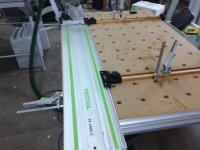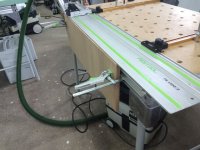sofa_king_rad
Member
- Joined
- Mar 26, 2016
- Messages
- 100
I'm new to woodworking and new to festool. I picked up the MFT3 table and a TS 55. I'm working on making some 3"x3" post to use for a kids bed. With the width being so narrow especially compared to the width of the track, I'm struggling.
I'm sure there is a simple technique, trick or jig to help. The post is too long for the flip down track of the Mft, but fine for the track 55 that came with the saw. I sort of rigged something up and got a cut done, but feel like there must be a better way.
Any tips? I have pard dogs, some quick clamps the black clamps that fit in like the part dogs.
I'm sure there is a simple technique, trick or jig to help. The post is too long for the flip down track of the Mft, but fine for the track 55 that came with the saw. I sort of rigged something up and got a cut done, but feel like there must be a better way.
Any tips? I have pard dogs, some quick clamps the black clamps that fit in like the part dogs.


